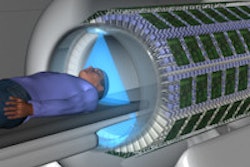Researchers from the U.S. Department of Energy's Lawrence Berkeley National Laboratory (Berkeley Lab) have demonstrated technology that could dramatically improve the resolution of ultrasound scans.
The group's technique can produce, detect, and control ultrahigh-frequency sound waves at the nanometer scale, according to Berkeley Lab. They believe the technology could ultimately yield ultrasonic imaging at potentially 1,000 times greater resolution than today's medical ultrasound scanning technology.
The method combines subpicosecond laser pulses and unique nanostructures to produce acoustic phonons -- quasiparticles of vibrational energy that move through an atomic lattice as sound waves -- at a frequency of 10 gigahertz (10 billion cycles per second), the lab said.
Medical ultrasound scans typically reach a frequency of only about 20 megahertz, or 20 million cycles per second. In addition to yielding increased resolution for acoustic imaging, the technique can also be used to visualize subsurface structures in nanoscale systems that optical and electronic microscopes can't see, Berkeley Lab said.
The team, led by Xiang Zhang, PhD, a faculty scientist with Berkeley Lab's Materials Sciences Division, shared the research in a paper published online June 4 in Nature Communications.



















